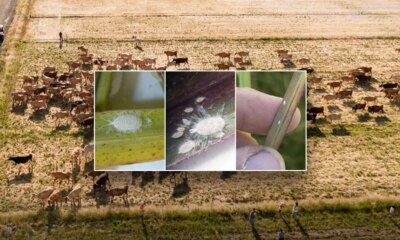Colorado
Colorado’s 5th measles case confirmed in Denver; people may have been exposed at Lakewood urgent care

People who visited Kaiser Permanente’s Lakewood facility on Saturday should monitor themselves for measles symptoms, after a Denver resident who caught the virus while in Mexico sought care there.
The adult patient — Colorado’s fifth confirmed measles case this year — visited the Kaiser urgent care clinic at 8383 W. Alameda Ave. People who spent time in the clinic between 10:30 a.m. and 1 p.m. Saturday could have encountered the virus.
Unlike the other four cases in Colorado this year, the latest patient — who had visited an area of Chihuahua, Mexico — had received the measles vaccine, according to the Colorado Department of Public Health and Environment. One dose of the vaccine is about 93% effective and two are 97% effective, meaning that some people can still get sick after vaccination.
“Cases like this are very rare,” Dr. Ned Calonge, the state health department’s chief medical officer, said in a news release. “Staying up to date on vaccinations and being aware of health risks when traveling are important ways to protect yourself and your community. We’re sharing this information out of an abundance of caution to support early detection and limit the risk of further spread.”
People who get a breakthrough case are less likely to spread the virus than unvaccinated people, but anyone exposed to the virus should watch for symptoms, including a fever, cough, runny nose and red eyes, Calonge said. If an exposed person develops symptoms, they should call ahead before seeking medical care, so the clinic can keep them away from susceptible patients.
Measles patients can spread the virus for about four days before and four days after the characteristic rash develops. Symptoms can show up seven to 21 days after exposure.
The most recent case is the fourth in Colorado linked to travel to Mexico, where the virus is spreading after an outbreak in Texas spilled across the border. The other three patients were a Pueblo County adult, a Denver infant and a person of unspecified age who lived in the same home as the baby.
An Archuleta County adult also developed measles. That person didn’t travel, and health officials aren’t sure where they got the virus.
Nationwide, 29 states have reported a combined 884 measles cases this year, which is more than triple the total last year, according to the Centers for Disease Control and Prevention.
The vast majority — 646 — are in Texas, where an outbreak in the western part of the state that’s approaching the three-month mark.
Two unvaccinated elementary school-aged children died from measles-related illnesses in the epicenter in West Texas, and an adult in New Mexico who was not vaccinated died of a measles-related illness.
The Associated Press contributed to this report.
Sign up for our weekly newsletter to get health news sent straight to your inbox.

Colorado
United States Postal Service offers reward after mail carrier robbed in Denver

The United States Postal Service is offering a reward for information on the person who robbed a Denver mail carrier this weekend.
According to the USPS Inspection Service, a man approached the letter carrier around 9:45 am.n. on Friday near Roslyn Street and 8th Place. Officials said he was around 5’5″ and was wearing a black mast, black jacket, blue jeans and black shoes. The USPS says a possible firearm was tucked in his belt.
They are offering a $150,000 reward for information that leads to the arrest and conviction of the person responsible for the robbery.
The USPS encouraged anyone with information on the case to contact their inspection service at 1-877-876-2455 or make a report online.
Colorado
Medina Alert issued after hit-and-run crash seriously injures motorist in Denver

DENVER — Authorities issued a Medina Alert Sunday following a hit-and-run crash that seriously injured a motorist.
Police said the driver of a gold 2008 BMW X3 SUV struck another vehicle at the intersection of Sheridan Boulevard and W. 17th Avenue in Denver around 4:37 p.m. Saturday.
The crash left the driver of the victim vehicle with serious bodily injuries, according to the Colorado Bureau of Investigation.
CBI
The BMW driver fled following the crash, traveling northbound on Sheridan Boulevard, CBI said in a bulletin.
The gold BMW X3, with Colorado license plate ECB F17, sustained heavy damage on the driver’s side from the collision.
If seen, call 911 or the Denver Police Department at 720-913-2000.
This was the second hit-and-run crash and Medina Alert in Denver on Saturday.
Earlier Saturday, a pedestrian in a crosswalk was seriously injured after being struck by a 2010 white Toyota Corolla, Colorado license plate EDM U42, at the intersection of Federal Boulevard and W. Kentucky Avenue.
The driver of the Corolla left the scene—heading northbound on Federal Boulevard.
No arrests have been announced.
A Medina Alert honors the memory of Jose Medina, a 21-year-old valet driver who was killed by a hit-and-run driver in 2011.
A taxi driver witnessed the event, followed the driver, and gave the police the license plate number, leading to the capture and arrest of the suspect.
Coloradans making a difference | Denver7 featured videos
Denver7 is committed to making a difference in our community by standing up for what’s right, listening, lending a helping hand and following through on promises. See that work in action, in the videos above.
Colorado
Denver shelter working to end homelessness for at risk youth, funding at risk
-

 Alaska1 week ago
Alaska1 week agoHowling Mat-Su winds leave thousands without power
-

 Texas1 week ago
Texas1 week agoTexas Tech football vs BYU live updates, start time, TV channel for Big 12 title
-

 Washington6 days ago
Washington6 days agoLIVE UPDATES: Mudslide, road closures across Western Washington
-

 Iowa1 week ago
Iowa1 week agoMatt Campbell reportedly bringing longtime Iowa State staffer to Penn State as 1st hire
-

 Miami, FL1 week ago
Miami, FL1 week agoUrban Meyer, Brady Quinn get in heated exchange during Alabama, Notre Dame, Miami CFP discussion
-

 Iowa2 days ago
Iowa2 days agoHow much snow did Iowa get? See Iowa’s latest snowfall totals
-

 Cleveland, OH1 week ago
Cleveland, OH1 week agoMan shot, killed at downtown Cleveland nightclub: EMS
-
World1 week ago
Chiefs’ offensive line woes deepen as Wanya Morris exits with knee injury against Texans
























